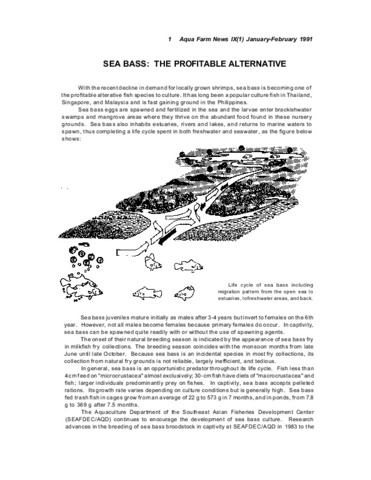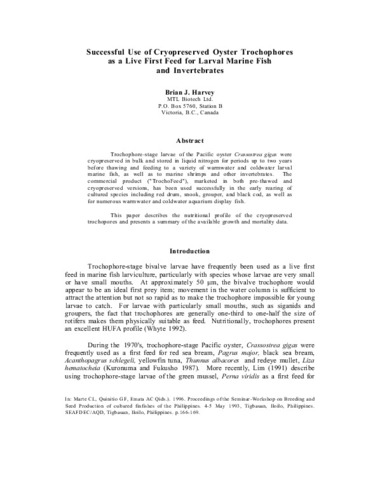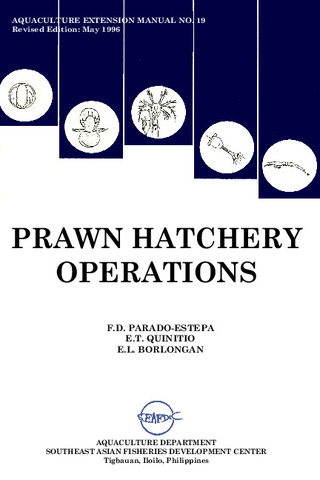The influence of monosex rearing on gonad maturation and reproductive behavior of Indian white prawn, Penaeus indicus broodstock
- Global styles
- MLA
- Vancouver
- Elsevier - Harvard
- APA
- Help

閲覧/開く
日付
2022-02著者
Page views
521ASFA keyword
AGROVOC keyword
Taxonomic term
Metadata
アイテムの詳細レコードを表示する
Share
抄録
Monosex culture was proven to be an effective rearing method for grow-out, but in a closed-cycle hatchery, males and females are usually reared communally in tanks until maturation. This study determined the effect of communal rearing (CR) and separate rearing (SR) on male and female Penaeus indicus broodstock gonad maturation. This study also evaluated the influence of the rearing method on reproductive behavior and mating success. The results showed that CR female broodstock had higher maturation rates at 77.78 ± 5.31% (p = 0.061) and a shorter latency period at 6.71 ± 2.54% than SR females (p = 0.211), but the differences were not statistically significant. Similarly, maturation rates for both male groups were 40.62 ± 3.12% and were not significantly different (p = 1.00). The interspermatophore period (p = 0.044), spermatophore weight (p = 0.878), count (p = 0.780), viability (p = 0.257), and percent abnormality (p = 0.257) did not vary between males. In terms of the effect of rearing method on reproductive behavior, males from the SR group initiated more chase (p = 0.018) and fight with other males (p = 0.022) than CR males did, and the differences were significant. SR males also touched the discarded molt (p = 0.167) and advanced to the probe position (p = 0.525) more times than CR males, but the differences were not significant. The sum of all the reproductive behaviors was also significantly higher in the SR (54.00 ± 1.20) than in the CR (24.20 ± 0.86) groups (p = 0.017). Initial results showed that successful mating in the SR (80%) was higher than that recorded in the CR group (20%). These findings suggest that monosex rearing of male and female P. indicus will not negatively affect gonad maturation and will enable sex-specific nutritional manipulations, which can even possibly promote higher mating success.
Suggested Citation
Santander-Avancena, S., Monteclaro, H., Estante-Superio, E., Catedral, D. D., & Traifalgar, R. F. (2022). The influence of monosex rearing on gonad maturation and reproductive behavior of Indian white prawn, Penaeus indicus broodstock. Aquaculture , 522, 738030. https://doi.org/10.1016/j.aquaculture.2022.738030
Type
ArticleISSN
0044-8486Collections
- Journal Articles [1258]
Related items
Showing items related by title, author, creator and subject.
-
Sea bass: The profitable alternative
Southeast Asian Fisheries Development Center, Aquaculture Department (Aquaculture Department, Southeast Asian Fisheries Development Center, 1991) -
Successful use of cryopreserved oyster trocophores as a live first feed larval marine fish and invertebrates
Harvey, Brian J. (Aquaculture Department, Southeast Asian Fisheries Development Center, 1996)Trochophore-stage larvae of the Pacific oyster Crassostrea gigas were cryopreserved in bulk and stored in liquid nitrogen for periods up to two years before thawing and feeding to a variety of warmwater and coldwater larval ... -
Series: Aquaculture extension manual; No. 19
Prawn hatchery operations
Parado-Estepa, Fe D.; Quinitio, Emilia T. ; Borlongan, Emeterio L. (Aquaculture Department, Southeast Asian Fisheries Development Center, 1996-05)
The manual, an updated version of the 1984 SEAFDEC/AQD manual, presents the underlying principles and step-by-step instructions of prawn larval and post-larval rearing. The techniques described are not only applicable to ...
; Borlongan, Emeterio L. (Aquaculture Department, Southeast Asian Fisheries Development Center, 1996-05)
The manual, an updated version of the 1984 SEAFDEC/AQD manual, presents the underlying principles and step-by-step instructions of prawn larval and post-larval rearing. The techniques described are not only applicable to ...





